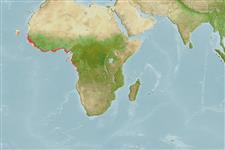Common names from other countries
Environment: milieu / climate zone / depth range / distribution range
Ekologi
laut; payau bentopelagis; kisaran kedalaman 10 - 75 m (Ref. 27000), usually 20 - 50 m (Ref. 81287). Tropical; 30°N - 17°S, 27°W - 13°E
Eastern Atlantic: West African coast, from Senegal to Angola (Ref. 7350, 81287). Also reported from the Canary Islands, Cape Verde (Ref. 7350) and Mauritania (Ref. 5377).
Size / Weight / umur
Maturity: Lm ? range ? - ? cm
Max length : 45.0 cm TL jantan/; (Ref. 1380); common length : 30.0 cm TL jantan/; (Ref. 3609); Berat maksimum terpublikasi: 750.00 g (Ref. 4883)
deskripsi pendek
Kunci identifiaksi (pengenalan) | Morfologi | Morfometrik
Duri punggung (Keseluruhan (total)) : 8 - 9; duri punggung lunak (Keseluruhan (total)) : 17 - 18; Duri dubur: 3; Sirip dubur lunak: 20 - 21. Diagnosis: body deep and strongly compressed, its anterior profile very steep up to dorsal-fin origin, and strongly compressed; head small; snout short; mouth small, terminal, strongly protrusible, with fleshy lips; teeth slender and pointed, set in bands in upper jaw; roof of mouth toothless; dorsal fin deeply notched; 1st dorsal fin spine small, forward-pointing and visible only in young individuals; pectorals falcate, very long, their tips almost reaching to caudal-fin base; hind margin of caudal fin slightly rounded; pelvic fins thoracic; scales finely ctenoid, covering body, bases of dorsal and anal fins and head, except snout and preopercle; preopercular margin denticulate; lateral line strongly arched (Ref. 81287).
Coloration: silvery grey, darker on back, almost white on belly; sides with a series of 8 brown, more or less faded vertical bars, always more distinct in young individuals (Ref. 81287).
Neritic species (Ref. 7350). Essentially marine, often living in groups (Ref. 81287) over sandy and muddy bottoms (Ref. 2683), between 20 and 50 m depth, and entering coastal lagoons where sexual maturation begins (Ref. 81287). Feeds of fish eggs, benthic invertebrates and detritus (Ref. 28587).
Life cycle and mating behavior
Maturities | Reproduksi, perkembang biakan | Spawnings | Egg(s) | Fecundities | Larva
Desoutter, M., 1990. Ephippidae. p. 834-836. In J.C. Quero, J.C. Hureau, C. Karrer, A. Post and L. Saldanha (eds.) Check-list of the fishes of the eastern tropical Atlantic (CLOFETA). JNICT, Lisbon; SEI, Paris; and UNESCO, Paris. Vol. 2. (Ref. 7350)
Status IUCN Red List (Ref. 130435)
CITES (Ref. 128078)
Not Evaluated
ancaman kepada manusia
Harmless
penggunaan manusia
Perikanan: nilai komersial kecil
Alat, peralatan
laporan khas
muat turun XML
Sumber internet
Estimates based on models
Preferred temperature (Ref.
115969): 19.2 - 28, mean 26.1 (based on 132 cells).
Phylogenetic diversity index (Ref.
82804): PD
50 = 0.7500 [Uniqueness, from 0.5 = low to 2.0 = high].
Bayesian length-weight: a=0.01413 (0.00737 - 0.02705), b=2.98 (2.81 - 3.15), in cm Total Length, based on LWR estimates for this species & (Sub)family-body (Ref.
93245).
Trophic level (Ref.
69278): 3.1 ±0.41 se; based on food items.
Daya lenting (Ref.
120179): sedang, Waktu penggandaan populasi minimum 1.4 - 4.4 tahun (K=0.13-0.25).
Fishing Vulnerability (Ref.
59153): High vulnerability (56 of 100).
